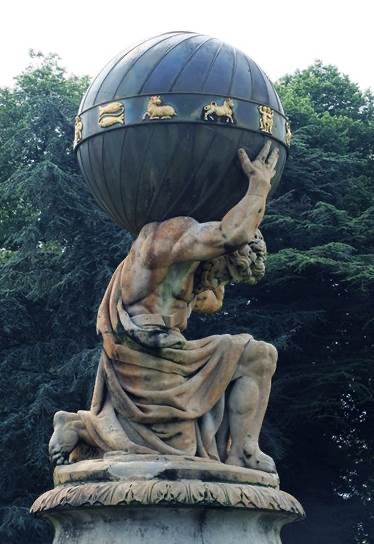The Hestia
Atlas: more than the man who holds up the sky?
By Andrew Zhang | 29.06.2024
Atlas was a Titan condemned to hold up the heavens for eternity after the Titanomachy – the ignominious defeat of the Titans to the Olympian gods led by Zeus and his allies. However, Atlas does not simply disappear from the canon of Greek mythology following his punishment. He plays a large role in myths of two of the greatest heroes: Heracles and Perseus.
As a Titan, Atlas was famed for his prodigious strength. Furthermore, he claimed to be skilled in philosophy, maths, astronomy and astrology, even credited with inventing even the first celestial sphere. Among his many children from his marriage to Pleione was Calypso, immortalised by Homer’s Odyssey in which she turned many of Odysseus’ men into swine.
The etymology of Atlas’ name is uncertain, but some say it consists of the prefix a- with the ancient Greek word τλῆναι – meaning “to bear”, an apt word to describe his hopeless predicament of carrying the burden of the heavens on his shoulders. .Despite this interpretation, some modern scholars insist that Atlas’ name is pre-Greek in origin. His epithet in Latin is durus (“hard”, “enduring”) given to him by Virgil whilst in Greek it is τελαμών (“enduring”).
Atlas’ legacy lives on through the many things still bearing his name. Ἀτλαντὶς νῆσος which means Atlas’ Island is the derivative from which we get the Atlantic Ocean Furthermore, we will all be familiar with the atlas – the name used to describe a collection of maps since the 16th century when Flemish geographer Gerardus Mercator published his work in honour of the mythological Titan.
Alternative perspectives of Atlas’ story
Atlas’ punishment has a striking resonance today, seeing parallels in the extortionate sums of money that the allies put it upon Germany to pay for starting the First World War.Atlas’ enduring task can be seen as a symbol of strength, resilience and endurance. Similarly, the Atlantic Ocean, the second largest ocean on the planet is named after Atlas, due to a Greek poet who named it the sea of Atlas. Atlas’ name is also used for the Atlas Mountains that separate the Sahara Desert from the Atlantic Ocean. These mountains are said to be the physical form of the petrified Titan or so Ovid seemed to believe. Atlas’ role in supporting the heavens can be interpreted as essential for maintaining the cosmic order.
Statues and Art
A common misconception is that Atlas’ task involved holding up the terrestrial globe, which represents the Earth’s surface and the geographical features of it. However, in many classical pieces of art, he is shown to be carrying and holding up the celestial spheres, which represent the cosmos, the skies and the heavens.

aLet’s first turn our attention to this statue outside the Rockefeller Centre. Atlas appears steady, securely holding up the institution of capitalism. This statue signifies Atlas’ strength and diverges significantly from other representations that emphasise the arduous, laborious nature of his punishment.

In some sculptures of the Titan, his face is expressionless, – interpreted either as an emblem of strength or possibly indifference. Some sculptures depict Atlas with his head tilted – naturally due to the hyperbolic weight of the world. Similarly, in some representations, Atlas gazes downwards buidling the impression of serving a punishment or pitiful fate.
Encounters with Perseus and Heracles
While Atlas had no myths of his own, he is mentioned in the tales of Greek heroes. One of these appearances occurs during the twelve labours of Hercules: the golden apples from Hera’s sacred garden. Hercules went to Atlas and offered to hold up the heavens whilst Atlas obtained the apples.
However, upon his return, Atlas attempted to trick Heracles into carrying the sky permanently by offering to deliver the apples on the crucial eleventh labour. Though, when Heracles asked Atlas to hold the sky up whilst he adjusted his cloak, Heracles took the apples and ran away. Thus, Atlas – the intelligent mathematician and philosopher – was outsmarted by Hercules – not one known for his cunning. In some versions of the myth, Hercules built the two great Pillars to hold up the sky – liberating Atlas as he did with Prometheus.
The story of Perseus’ meeting with Atlas, different to that of Heracles, was told by the Greek poet Polyidus. In this meeting, Perseus turned Atlas, then a shepherd, into stone using Medusa’s head. Ovid, writing during the Roman period, gave a more detailed mythological account. According to this myth, Atlas was not a shepherd but a king when Perseus arrived in his kingdom and asked for shelter, declaring that he was the son of Zeus. In this story, Atlas denied him hospitality, fearful of a prophecy that a son of Zeus would steal his golden apples. Hence, he was turned into a large rock formation: the aforementioned Atlas Mountains. The prophecy did not concern Perseus himself but about a certain Heracles, a descendant of the legendary hero.
Today, Atlas stands as a symbol of strength and might in the face of hardship, although different interpretations exist. His influence extends beyond the mythical realm of Greek stories, seen from his representations in art and sculpture to the oceans and geological features that bear his name.